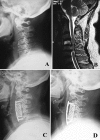Comparative analysis of complications of different reconstructive techniques following anterior decompression for multilevel cervical spondylotic myelopathy
- PMID: 22644433
- PMCID: PMC3508223
- DOI: 10.1007/s00586-012-2323-y
Comparative analysis of complications of different reconstructive techniques following anterior decompression for multilevel cervical spondylotic myelopathy
Abstract
Purpose: Anterior approach was extensively used in surgical treatment of multilevel cervical spondylotic myelopathy. Following anterior decompression, many different reconstructive techniques (multilevel ACDF, hybrid construct and long corpectomy) all had satisfied outcomes. However, there are few studies focusing on the comparison of these three reconstructed techniques. The aim of this retrospective study was to analyze the complications of these three different methods.
Methods: This study retrospectively reviewed the complications in 286 consecutive patients with multilevel CSM who underwent anterior cervical surgery from 2005 to 2010. This case series had 166 men and 120 women whose mean age at surgery was 53.8 years (range from 33 to 74 years). Radiographic evaluation was taken the day after surgery, and the flexion-extension X-rays were added 3, 12 and 24 months postoperatively to evaluate the fusion condition. Preoperative versus postoperative neurologic function and clinical outcome were evaluated using scoring systems such as the Japanese Orthopedic Association (JOA score), Neck Disability Index (NDI score) and 36-Item Short-Form Health Survey (SF-36 score).
Results: There were no significant differences in JOA scores, NDI scores and SF-36 scores of the pairwise comparison among the three groups. The complications in our series included graft migration, collapse or displacement, hoarseness, dysphagia, C5 palsy, cerebral fluid leakage and wound infection. Sixty-one patients developed complications after surgery and the rate of complication was 21.33 %. Patients in the long corpectomy group had the highest rate of complications; the other two groups had a much lower rate of complications by the latest follow-up. The patients in the multilevel ACDF group had the highest fusion rate by the last follow-up. Patients who had C2-3 and C3-4 segments involved had a higher rate of postoperative hoarseness and dysphagia.
Conclusions: Most of the complications of the three reconstructive techniques subsided gradually after conservative treatment; none of them needed revision surgery. The multilevel ACDF approach has the lowest rate of non-union, but a slightly higher morbidity of the laryngeal nerve-related complication if proximal segments were involved. The long corpectomy approach should be selected prudently because of the high rate of complication.
Figures




References
-
- Papadopoulos EC, Huang RC, Girardi FP, Synnott K, Cammisa FP., Jr. Three-level anterior cervical discectomy and fusion with plate fixation: radiographic and clinical results. Spine. 2006;31(8):897–902. doi: 10.1097/01.brs.0000209348.17377.be. - DOI - PubMed
Publication types
MeSH terms
LinkOut - more resources
Full Text Sources
Medical
Miscellaneous

